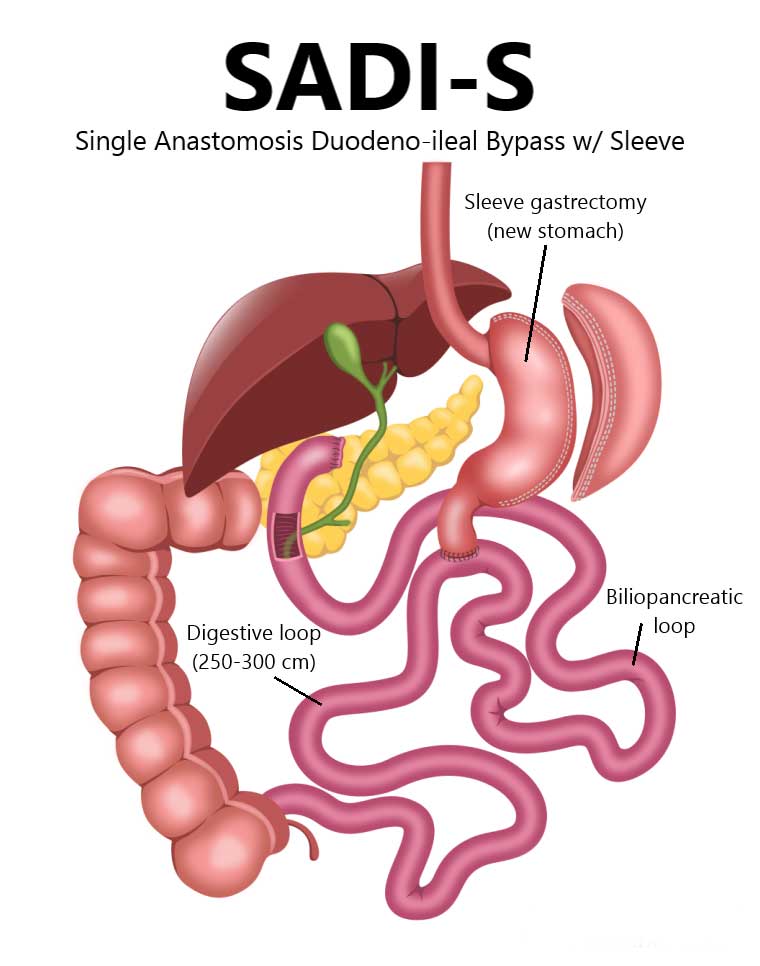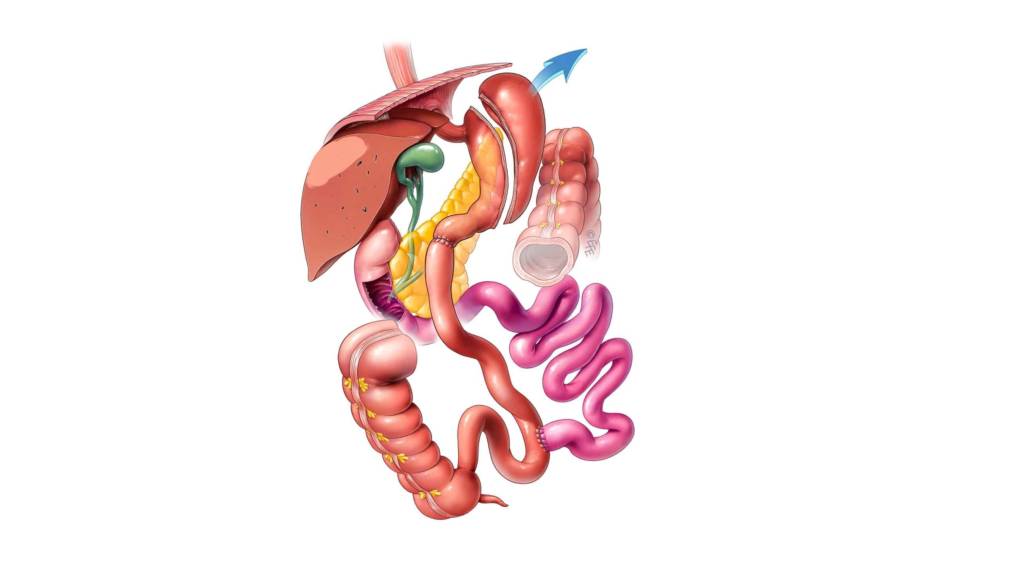The SADI-S (Single Anastomosis Duodeno-Ileal bypass + Sleeve) operation is the modern version of biliopancreatic shunting, which is most often performed in the laparoscopic version. The operation has all the advantages of single-anastomosis bypass procedures – greater safety, lower risks due to reduced trauma of the intervention when performing only one anastomosis.
With this type of shunting, a large part of the small intestine is turned off from the processes of complete digestion, the length of a fully functioning intestine is about 3 meters – this allows you to achieve the effect of maximum malabsorption (restriction of absorption, primarily of fats and carbohydrates).
The operation requires maximum constant monitoring of all indicators of the body after the operation, since the risk of developing protein and a number of vitamins losses after the operation is higher than after other types of interventions.
In practice, it is rarely used as a primary operation. More commonly, SADI-S is performed as a re-intervention after a longitudinal gastrectomy or other restrictive procedures, if necessary.

The SADI-S operation consists of two components: laparoscopic longitudinal resection of the stomach (restrictive component), as well as anastomosis between the duodenum and the small intestine at a distance of approximately 3-3.5 meters from its confluence with the large intestine (malabsorptive component) .
Since the stage of longitudinal (or sleeve) resection of the stomach is performed, the operation is irreversible.
The duration of the operation is 1.5-2 hours (depending on whether it is primary or repeated). The postoperative period is similar to the longitudinal resection of the stomach. The patient’s stay in the hospital to 2-3 days.
What does it lead to?
As a result of the operation, the volume of the stomach is reduced, the amount of food taken at a time is reduced. By removing the part of the stomach that produces the hunger hormone ghrelin, the feeling of hunger is reduced, the person is saturated with less food. As a result of the operation, the amount of absorbed nutrients is reduced. The patient, as a rule, loses almost all excess weight within a year.
In the postoperative period, it is strictly necessary to take vitamin-mineral complexes.
Advantages of the SADI operation:
• There is no disconnected part in the formed stomach, as in traditional gastric bypass;
• The part of the stomach that produces the hunger hormone ghrelin is removed;
• Preservation of the pyloric part of the stomach provides a more functional movement of food into the intestine, thereby reducing the likelihood of dumping syndrome, manifested by nausea, dizziness, excessive sweating, rapid heartbeat, general weakness;
• A pronounced and stable effect of weight loss is provided in patients who previously underwent a longitudinal resection of the stomach, which did not bring the desired results;
• Reduced risk of uncontrolled metabolic disorders associated with malabsorption.
The procedure is indicated for patients:

• With severe forms of obesity with a body mass index of 40 kg / m² and above, but has real advantages with a BMI of more than 50 kg / m²;
• Suffering from type II diabetes mellitus with a BMI of 30 kg / m² as one of the methods for treating endocrine pathology;
• As a revision (repeated) operation in case of insufficient efficiency of the performed operation of the longitudinal resection of the stomach (it is most often used in this variant).
Benefits of choosing AstraMedicaGroup
Only top qualified doctors
JCI certificated hospitals
Free COVID-19 Test before departure
4 nights in a 5-star hotel in Istanbul
Costs for laboratory, medication and equipment
Pre/post-operative tests
Free Istanbul tours
Latest technologies
Excelent travel assistance
All-round VIP transfer
Credit / Debit cards accepted
No prepayment
Personal assistants speak in English
24/7 customer service
